Disciplinary Warning Letter To Employee
Subject: Disciplinary Warning Letter
Dear [Employee's Name],
I hope this letter finds you well. We are writing to inform you that we have noticed certain concerns regarding your performance and conduct at work. As an employee of [Company Name], it is important to adhere to our established policies and meet the expected standards of professionalism. Therefore, we must address these issues promptly to ensure a harmonious work environment.
The following incidents have come to our attention:
1. [Describe the specific incident(s) in detail, including date(s) and time(s). Be objective and factual, avoiding any personal opinions or assumptions.]
2. [Provide details of any previous verbal warnings or discussions, if applicable.]
3. [Clearly explain how the incidents mentioned above violate company policies or expectations.]
As an employee, it is essential that you understand the significance of adhering to our policies and the impact your actions can have on the overall functioning of the company. We value our employees and aim to provide a supportive work environment, which includes holding each individual accountable for their behavior and performance.
Moving forward, we expect the following:
1. Compliance with company policies and guidelines at all times.
2. Improvement in your overall performance and conduct.
3. Regular attendance and punctuality.
4. Professionalism in your interactions with colleagues, supervisors, and clients.
5. Diligence in completing assigned tasks and meeting deadlines.
To support your improvement, we suggest the following steps:
1. Review the company policies, including the employee handbook, to ensure a clear understanding of the expected behavior and performance standards.
2. Seek guidance from your supervisor or HR representative for any clarification or assistance required.
3. Take proactive steps to address any skill gaps or areas of improvement through additional training or professional development opportunities.
Please be aware that further disciplinary action, including suspension or termination, may be taken if there is no notable improvement in your performance and conduct within the specified time frame.
We strongly encourage you to take this warning seriously and make the necessary changes to meet our expectations. We believe in your potential and hope to see significant progress in the coming weeks. If you have any questions or concerns, please do not hesitate to reach out to your supervisor or the HR department.
We trust that you will treat this matter with the utmost seriousness and commitment. We look forward to your cooperation and improvement.
Sincerely,
[Your Name]
[Your Position]
[Company Name]
Formal Disciplinary Warning Letter
Subject: Formal Warning Regarding Misconduct
Dear [Employee Name],
This letter serves as a formal disciplinary warning concerning your recent conduct at the workplace. On [specific date], it was observed and recorded that [describe incident or behavior]. Such behavior is not aligned with the standards, policies, and expectations of our organization.
We value your contribution to the team, but we must emphasize that this type of conduct cannot continue. Any further instances of similar behavior may result in more severe disciplinary action, which could include suspension or termination.
We strongly advise you to take this warning seriously and work towards correcting your behavior. Please consider this an opportunity to improve and demonstrate your commitment to maintaining a professional and respectful workplace.
Sincerely,
[Manager’s Name]
[Title]
Preliminary Warning Email
Subject: Preliminary Warning About Conduct
Hi [Employee Name],
This is an early notification regarding some concerns we’ve noticed about your performance and conduct. Specifically, [briefly mention the issue]. While this is not a formal disciplinary action yet, it is important to acknowledge it before it escalates.
We trust that you will take steps to address this matter immediately. Please use this message as a chance to reflect and make improvements so we don’t have to proceed with a more formal step.
Thank you for your cooperation.
Best regards,
[Supervisor’s Name]
Serious Official Warning Letter
Subject: Official Disciplinary Warning
Dear [Employee Name],
We are issuing this official warning due to a serious breach of company policy that occurred on [date]. The incident involved [describe details], which directly violates [policy or code of conduct section].
This letter will be placed in your personnel file as a record of disciplinary action. Further violations of a similar nature may result in suspension or termination from your role.
We urge you to correct this behavior immediately. Please meet with [HR or Manager] to discuss steps to ensure compliance moving forward.
Sincerely,
[Manager’s Name]
[Title]
Casual Reminder Message
Subject: Friendly Reminder
Hello [Employee Name],
I just wanted to reach out about a small but recurring issue we’ve noticed—[mention the issue lightly]. It’s not a major problem yet, but it’s important that we resolve it before it becomes a bigger concern.
Consider this a gentle reminder rather than a formal warning. We appreciate all the hard work you do and want to make sure we stay on the right track together.
Best,
[Manager’s First Name]
Attendance Violation Warning Letter
Subject: Warning for Attendance Irregularities
Dear [Employee Name],
This letter is to formally warn you regarding your attendance record. We have observed repeated tardiness and unapproved absences over the past [time period]. Reliable attendance is a basic requirement of your role and a key part of maintaining team efficiency.
If there are underlying issues contributing to these absences, we encourage you to inform us so we can provide the necessary support. However, continued violations will lead to further disciplinary measures.
Please take corrective action immediately to avoid escalation.
Sincerely,
[Manager’s Name]
[Title]
Performance Improvement Warning Letter
Subject: Performance Warning
Dear [Employee Name],
We are concerned about your recent performance levels, which have not met the standards expected for your role. Specifically, [list areas of concern]. Despite previous discussions and feedback, little progress has been made.
This is a formal warning. Improvement is necessary and must be demonstrated within the next [timeframe]. Failure to improve may result in further disciplinary action, up to and including termination.
We encourage you to take advantage of any available resources, such as training or mentoring, to help you succeed.
Sincerely,
[Manager’s Name]
[Title]
Final Warning Letter
Subject: Final Warning Before Termination
Dear [Employee Name],
This is your final disciplinary warning. Despite prior warnings regarding [state issue], the problem has continued without sufficient improvement. Such repeated behavior is unacceptable and cannot be tolerated.
Unless immediate and sustained improvement is observed, termination of your employment will be the next step. This letter is a last opportunity to correct your conduct.
We strongly advise you to take this matter with the utmost seriousness.
Sincerely,
[Manager’s Name]
[Title]
Provisional Warning Message
Subject: Provisional Warning
Dear [Employee Name],
We are issuing this provisional warning to bring your attention to [specific issue]. While this is not yet a final decision, it is an indication that your behavior is under review and may lead to more serious consequences if not corrected.
You are encouraged to submit your explanation regarding the matter and take corrective action promptly. Your cooperation and commitment to resolving this issue will help determine the next course of action.
Sincerely,
[Manager’s Name]
[Title]
Informal Verbal Warning Follow-up Email
Subject: Follow-Up on Verbal Warning
Hi [Employee Name],
As discussed in our recent meeting, I wanted to follow up in writing about the verbal warning regarding [specific issue]. Please treat this email as a confirmation of what was said and as a reminder that improvement is expected.
We trust that you will make the necessary adjustments, and we look forward to seeing progress.
Thank you,
[Manager’s Name]
Team Impact Warning Letter
Subject: Warning Regarding Team Conduct
Dear [Employee Name],
This letter is to notify you that your recent actions have negatively impacted team morale and collaboration. On [date], [describe situation], which created disruption and affected others’ productivity.
We cannot allow behavior that undermines teamwork and respect in the workplace. Please take this as a warning to adjust your approach and interactions immediately.
Sincerely,
[Manager’s Name]
[Title]
What is a disciplinary warning letter and why is it needed?
A disciplinary warning letter is a formal communication from an employer to an employee that highlights misconduct, poor performance, or a breach of workplace policy. Its main purpose is to document the issue, give the employee a chance to correct it, and protect the organization legally by showing due process. It serves as both a record and a corrective tool.
Who should send a disciplinary warning letter?
The letter should typically come from a direct supervisor, line manager, or the Human Resources department. In cases of serious violations, senior management or HR may handle the letter to emphasize its importance. The sender should always be someone with authority to issue discipline.
Whom should the disciplinary warning letter be addressed to?
The letter should be addressed to the specific employee involved. In cases of joint responsibility, separate letters should be issued to each individual. It should never be addressed to a group as that dilutes accountability and confidentiality.
When should a disciplinary warning letter be issued?
- After repeated minor misconduct that has not been corrected.
- Following a serious violation of company policy.
- When performance is consistently below acceptable standards.
- As a follow-up to informal warnings or verbal notices.
- When attendance, punctuality, or behavior issues affect the workplace.
How do you write and deliver a disciplinary warning letter?
- Begin with the subject and greeting, making it clear it is a warning.
- State the issue in factual, objective terms.
- Reference company policies or expectations violated.
- Outline the consequences of not correcting the behavior.
- Keep the tone professional, avoiding personal remarks.
- Deliver the letter in person when possible, followed by a copy via email or HR filing.
How many warnings are usually given before termination?
Many organizations follow a "progressive discipline" model:
- Verbal warning
- Written warning
- Final written warning
- Termination
However, severe violations like theft or harassment may justify immediate dismissal without multiple warnings.
Requirements and prerequisites before sending a disciplinary warning letter
- Clear documentation of the misconduct or performance issue.
- Evidence such as attendance logs, reports, or witness statements.
- Prior discussions or attempts at informal correction.
- Knowledge of company policy and disciplinary procedures.
- Approval from HR or higher management before issuing the letter.
Formatting guidelines for disciplinary warning letters
- Length: usually one page, concise but detailed enough.
- Tone: professional, serious, and neutral.
- Wording: objective, avoiding emotional or accusatory language.
- Style: formal for official letters, but tone can vary depending on severity.
- Mode: physical letter for official records, email for preliminary warnings.
- Etiquette: deliver privately, respecting the employee’s dignity.
After sending: what follow-up is needed?
- Schedule a meeting to discuss the letter with the employee.
- Set a clear timeframe for improvement.
- Monitor the employee’s progress regularly.
- Document all interactions related to the case.
- Confirm receipt of the letter, either signed or acknowledged in email.
Pros and cons of sending disciplinary warning letters
Pros:
- Creates a clear record of issues.
- Gives the employee a fair chance to improve.
- Protects the organization from legal risk.
- Reinforces policies and standards.
Cons:
- May affect employee morale negatively.
- Could damage manager-employee relationship.
- Risk of escalating conflict if not handled well.
Compare and contrast with other types of workplace notices
- Disciplinary warning vs. performance review: Reviews focus on improvement and development, warnings focus on consequences.
- Warning letter vs. termination letter: Warnings give a chance to correct, termination ends employment.
- Informal feedback vs. warning letter: Feedback is conversational; warnings are documented and formal.
Tricks and tips for writing effective disciplinary warning letters
- Stick to facts, not emotions.
- Cite exact dates, times, and incidents.
- Keep the language professional but clear.
- Avoid vague phrases like "bad attitude."
- Always mention the next steps and possible consequences.
- Involve HR to ensure compliance with labor laws.
Common mistakes to avoid in disciplinary warning letters
- Using overly harsh or emotional language.
- Failing to specify what behavior needs correction.
- Skipping documentation of prior issues.
- Issuing group warnings instead of individual letters.
- Forgetting to outline next steps or consequences.
- Not giving the employee a chance to respond.
Essential elements and structure of a disciplinary warning letter
- Subject line identifying it as a warning.
- Clear greeting addressing the employee by name.
- Statement of the issue or misconduct.
- Reference to violated policy or expectation.
- Warning of future consequences.
- Encouragement to improve.
- Closing statement and signature.
- Attachments if needed (evidence, reports).

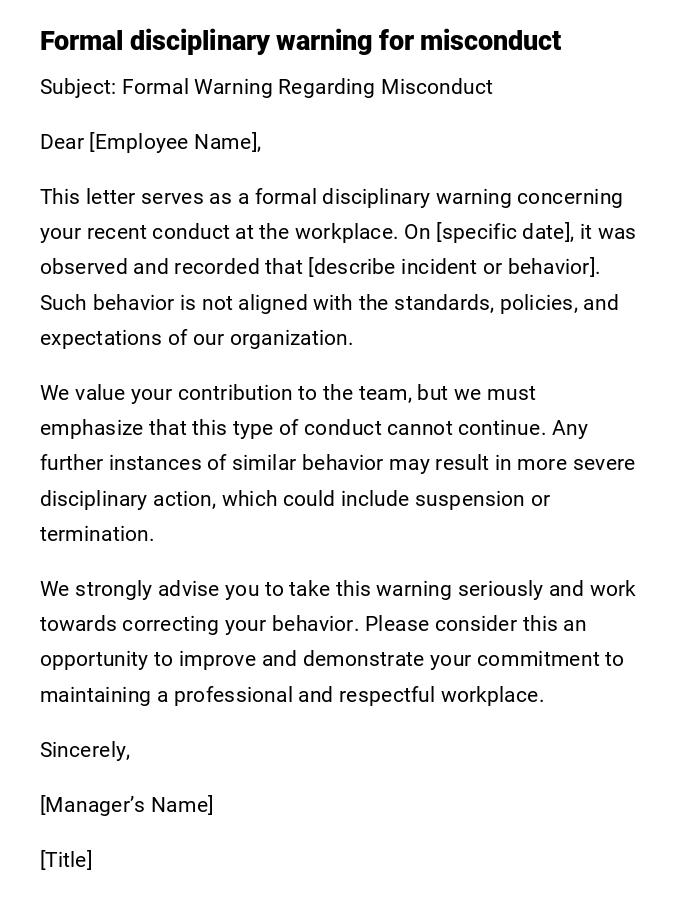
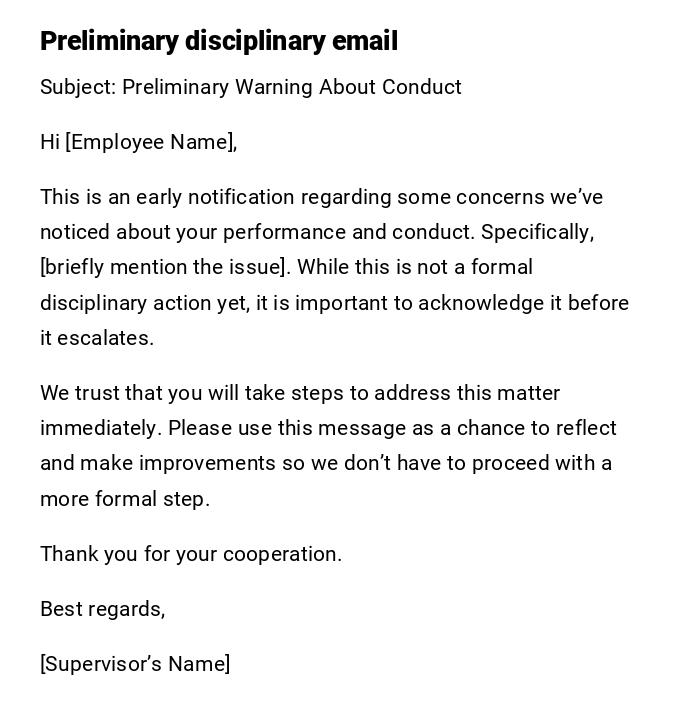
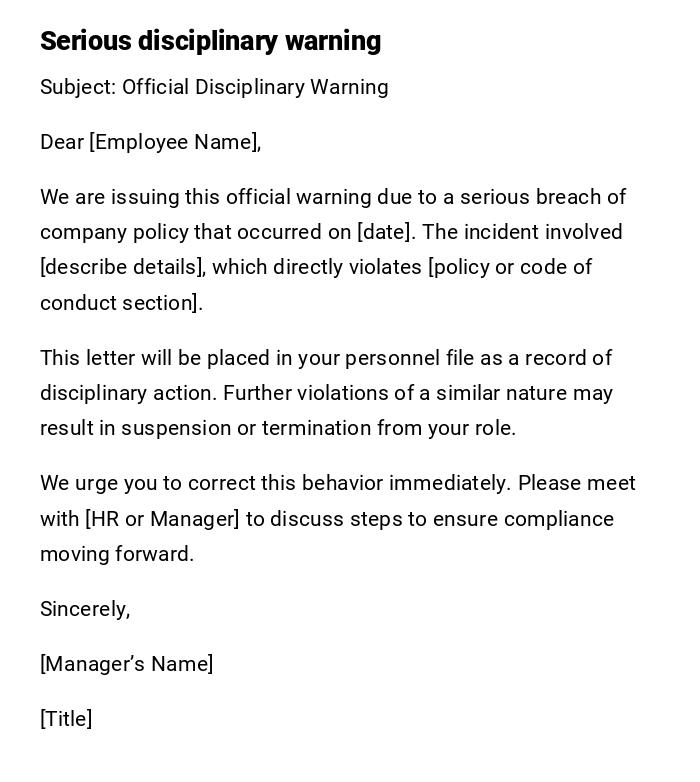
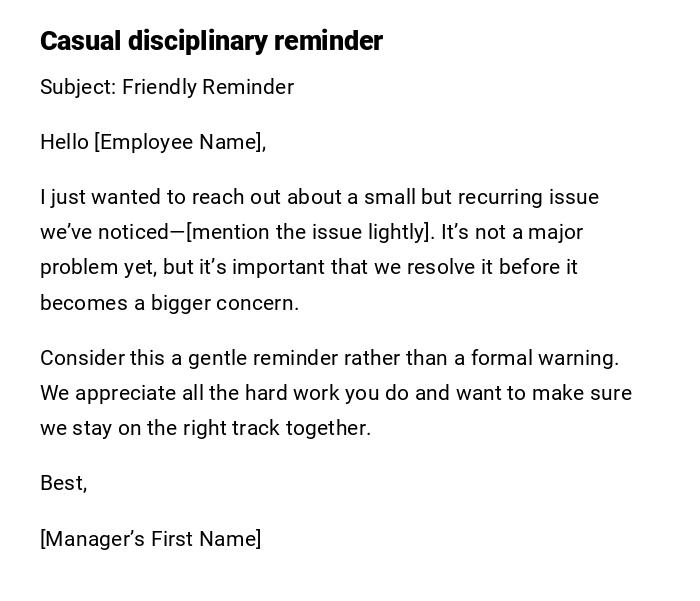
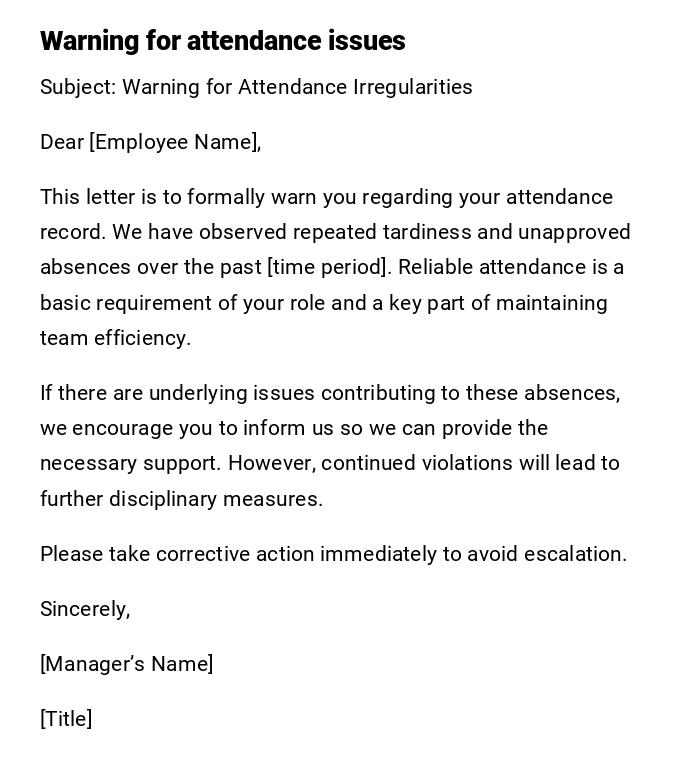
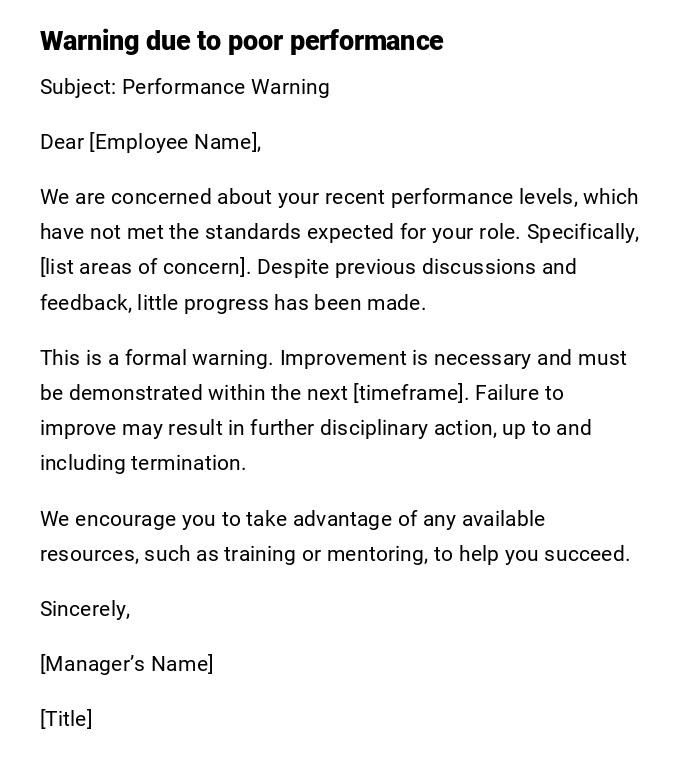
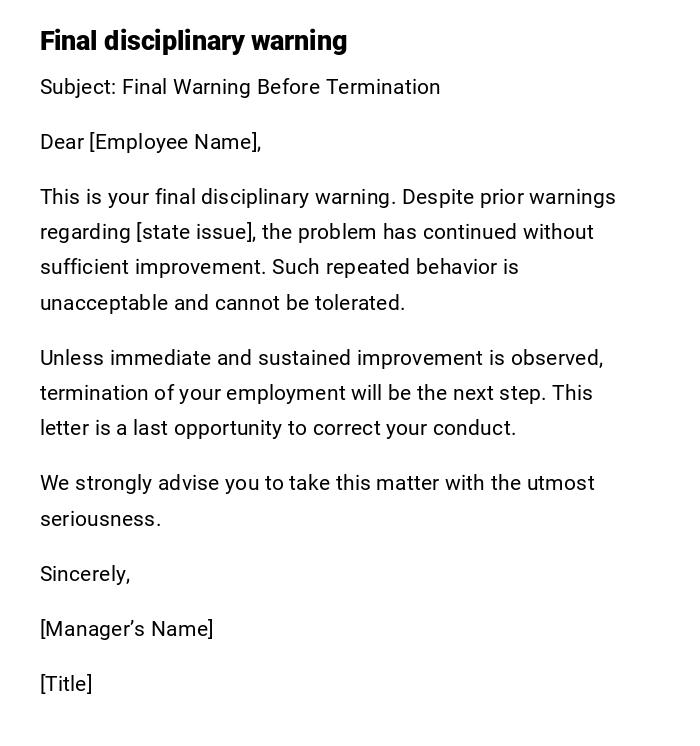
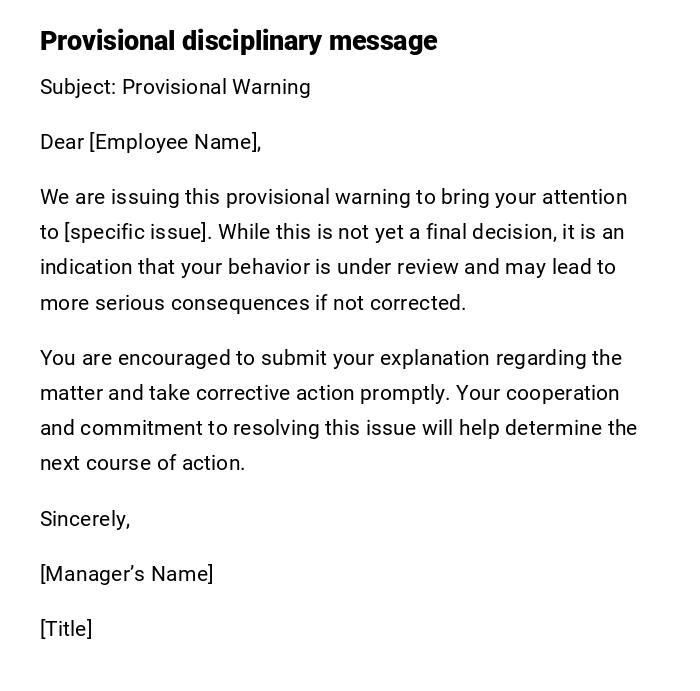
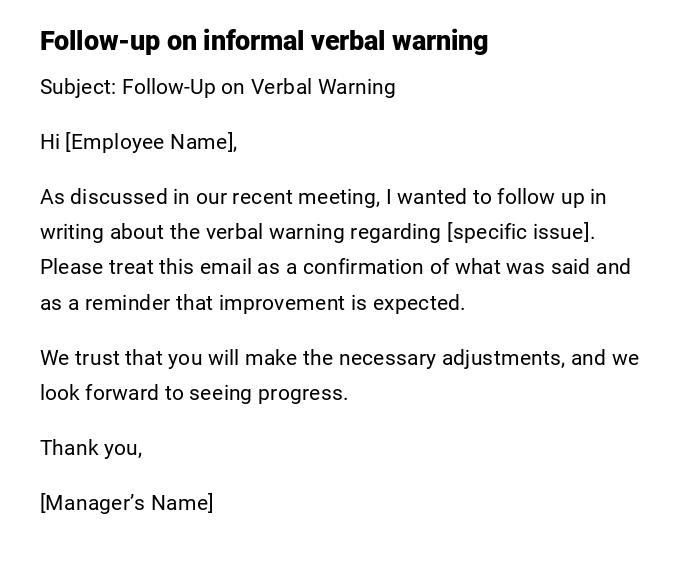
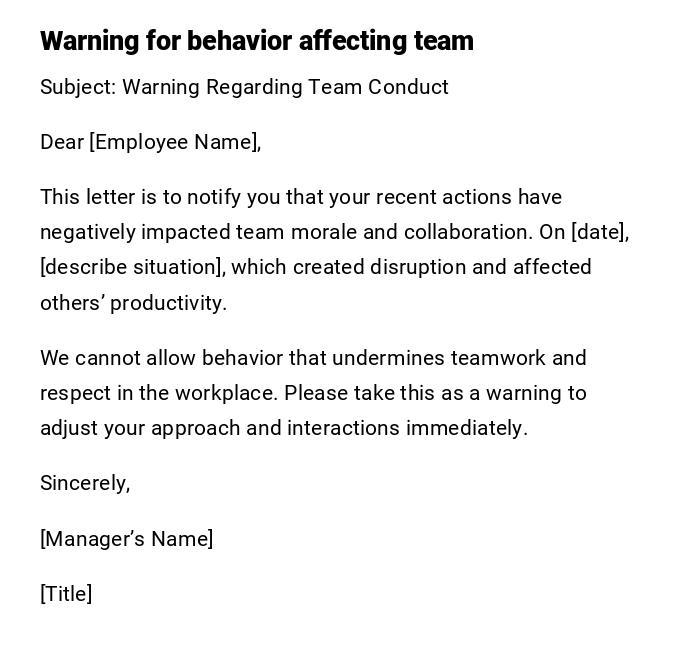

 Download Word Doc
Download Word Doc
 Download PDF
Download PDF